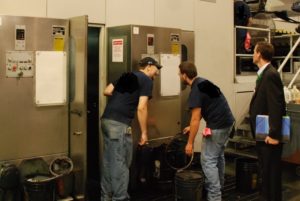“Safety comes first as a global standard”
Everyone in the world, without doubt, hopes for no accidents in their workplaces.
When the U.S was in a recession in the early 1900s, blue-collar workers were forced to work in harsh conditions engaging in dangerous operations, which resulted in a large number of labor accidents. Now, looking back on that period of time, we can describe it as the era of“First comes production”, second comes quality, and safety is the third priority”
Mr. Elbert Gehry, president of US Steel, who was a devout Christian set the company’s management policy, “Safety first, quality second, production third”. Then, the workers’ accidents decreased, and quality and production increased.
I (Mr. Taniguchi, CEO) visited the independent corrugated factory P company on the east coast of the United States. They are committed to achieving the goal of zero accidents. We can learn from their attitude of trying to achieving an accident-free workplace through teamwork.
Specifically, when operators change shifts, they meet and check their physical condition as well as confirm the instructions and production schedules, much the same as aircrew men perform before boarding an airplane. After arriving at the production line, they stick nameplates of all the members of a team with a magnet on a board at the side of a machine.
During my plant visit a team of four people had been working at an 8 color flexo printing press. They appeared to be very proud of their professional manner in the safely-managed production plant. The most important workplace safety criterion is“zero occupational accidents”. To achieve this you need to actively introduce good examples of safety management and practice them.






